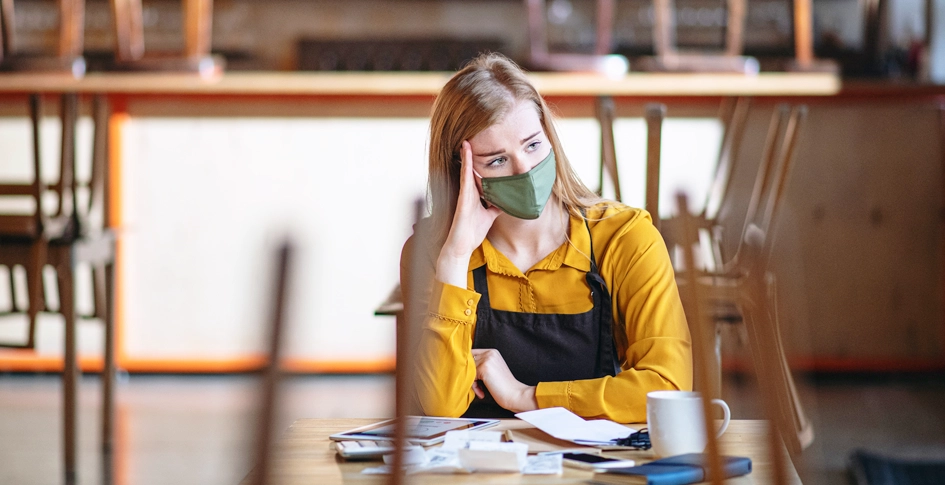“We went through four large waves in New York City[...and] it really kind of dawned on me: ‘we’re having the exact same conversations.’[....]People would say, ‘well, it’s only cases increasing, let’s see what happens to hospitalizations.’[...]And you’re like, ‘wow, when are we going to learn.’”
After 3 years of the pandemic, there is one thing we can say about COVID-19 for certain: it's not going anywhere. Organizations can't let wishful thinking blind them to this fact. In this blog, we will discuss 5 reasons why COVID remains a concern and what organizations should do about it.
1. Coronaviruses mutate
All coronaviruses—not just SARS-CoV-2—develop new variants to sidestep a population's immunity. For instance, the mutation rate of the 4 other coronaviruses cycling in the United States is one reason you can get the common cold every year.
As Tom Peacock of the Imperial College London told Stat News, each successful variant of SARS-CoV-2 will necessarily be the “most immune evasive yet” because that's the only way it can succeed in the first place. Thus, COVID will continue to spread widely.
It's likely that this autumn's variant-fueled wave of COVID has already begun. Experts are tracking dozens of new sub-variants of Omicron, some of which account for a growing percentage of total COVID infections. Some sub-variants of note are BA 4.6 (on the rise in the United States), XXB (on the rise in Asia), BA 2.75.2, and BQ.1.1. Despite their different lineages, many of these variants have similar changes in their spike proteins, which suggests that they've found a way around existing immunity. Like overly-aggressive software updates, SARS-CoV-2 will keep giving us new versions of itself…whether we want it to or not.
However, experts don't know which of these variants will produce the next wave yet. The aforementioned Dr. Peacock adds, “‘It’s a little bit like what we would expect to see over a couple years of flu, but crammed into about three months with SARS-CoV-2[...]We could end up with a mix [of variants], and different countries end up with different mixes.’” Alternatively, a previously unidentified variant could surprise us. All we can know for certain is that a wave will occur.
2. Human immunity wanes
Like a country whose war has ended, our bodies don't keep all our immune defenses mobilized once a threat has passed (at least for most diseases). In the first 6 months after acquiring a particular SARS-CoV-2 variant, humans still have enough active antibodies to make reinfection by the same variant extremely unlikely. Eventually, though, antibody levels begin to decline. Vaccines produce a longer-lasting immune response than the disease itself, but even this response wanes too.
 Organizations risk seeing their staff dwindle during COVID surges. (Image credit: Getty / pixelfit)
Organizations risk seeing their staff dwindle during COVID surges. (Image credit: Getty / pixelfit)
3. Long COVID can disrupt lives for years
Long COVID refers to a host of debilitating conditions which can occur after a person has recovered from a COVID-19 infection; (please see our previous article on long COVID for more information). A study of hospitalized COVID-19 survivors in Wuhan found that most sufferers of long COVID waited at least a year before their symptoms began to improve. (However, this would not necessarily apply to those who suffer from more permanent conditions associated with long COVID such as stroke or diabetes.) As a busy building or business manager, ask yourself if you can afford to have 5 to 50% of COVID-positive personnel sick for at least a year.
 Unless we make radical changes in how we think about infection, COVID-19 will continue to disrupt the way we live, work, and play. (Image Credit: Getty / AndreyPopov)
Unless we make radical changes in how we think about infection, COVID-19 will continue to disrupt the way we live, work, and play. (Image Credit: Getty / AndreyPopov)
The private sector can lead the way
Considering the endemic and devastating nature of COVID, the only logical organizational response is to reduce infections in the first place. This requires keeping up with existing precautions (such as access to testing), but it also means fundamentally changing the environment in which the virus spreads best—indoor air.
Experts are now certain that COVID-19 primarily spreads via indoor air. They also know that the so-called “droplet dogma,” (i.e., that respiratory illnesses only spread through large droplets limited to 6 feet around an infected individual) is incorrect. SARS-CoV-2 can spread through small aerosols which travel across the room and hang in the air for hours.
Much like the 19th century was surprised to learn that typhoid and cholera were spread by untreated water, our century is learning that respiratory diseases come from untreated air. The pandemic and its consequences will continue until indoor air treatment becomes as standard as indoor water treatment. As we've discussed in previous articles, such indoor air treatment must actively address contaminants in occupied rooms, not passively clean circulated air. ActivePure Technology is just such an active technology, one which has been proven to radically reduce airborne SARS-CoV-2 particles.
Private organizations don't need to wait for the government to make such a change. Rethinking indoor air quality is profitable enough that businesses can lead the way. (As a side note, the government is providing an unprecedented amount of funding in the hopes that organizations will improve indoor air quality voluntarily.)



